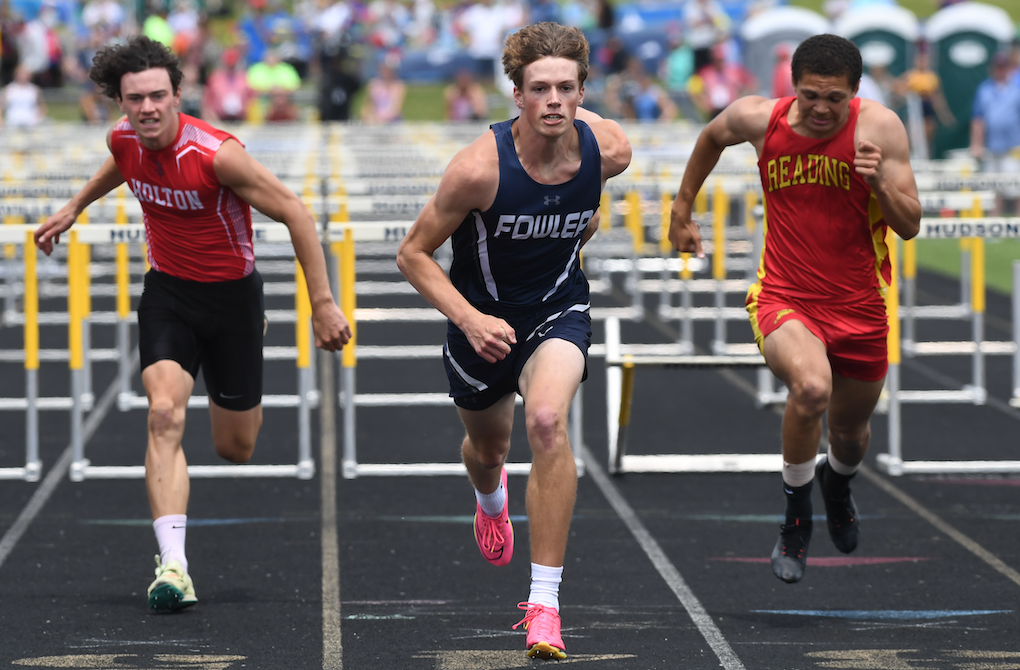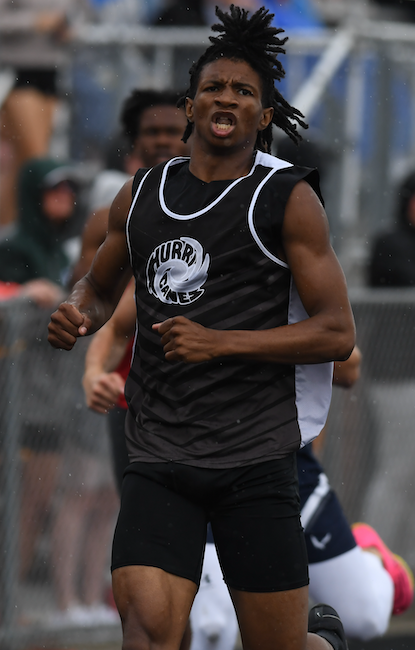
Track Gaining Speed Toward Future with Electronic Starting Devices
By
Steve Vedder
Special for MHSAA.com
May 23, 2023
Aubrey Greenfield thinks it might be the perfect time to reevaluate 130 years of tradition.
For a number of reasons, from technical to personal, the Oxford senior sprinter believes it makes sense for the crack of a starting pistol to be eliminated from high school track meets.
Because track meets would benefit in various ways from lowering costs to easier setup at meets to the human factor of competitors not having to flinch at the crack of a pistol shot, Greenfield believes the sport has a chance to embrace new technology – electronic starting devices (ESD).
In essence, an ESD replaces the starting pistol with a light flash, tone sound or both to begin a race.
"High school sports should put the athlete first," Greenfield said. "We should promote sports, and eliminating starting pistols promotes health in terms of PTSD or trauma for athletes and spectators and that would be good. I would like to think people would say that's a good idea."
In fact, Greenfield would go as far as to say if there was not an implementation of electronic starting devices, many of her teammates would have considered giving up the sport.
"If it's something that helps us compete safely, we're all for it," she said.
Greenfield's opinion apparently is spreading. Michigan High School Athletic Association senior assistant director Cody Inglis said the use of ESD makes it both affordable for meet starters and sensible for athletes and fans to rethink the use of starting pistols. While the MHSAA is not mandating electronic starting devices, it does promote the use of what Inglis calls "emerging technology." He notes that ESD are becoming the norm for organizations such as USA Track & Field, the NCAA and an increasing number of high schools.
 "I think we have to embrace new technology, and we think this will be something that takes hold," Inglis said.
"I think we have to embrace new technology, and we think this will be something that takes hold," Inglis said.
A key part of embracing ESD is the human element. The tragic Oxford High School shooting Nov. 30, 2021, that took the lives of four students while injuring seven others should not be relived even for a fleeting instance at a high school sporting event. Oxford athletic director Tony DeMare said the school began using ESD at every meet, including the MHSAA Lower Peninsula Division 1 Finals last June. He said that decision was embraced by virtually all schools Oxford encountered.
"We were very convinced that the alternative (of ESD) would promote a healthy attitude," DeMare said. "We were overwhelmed with the positive response. If a school was on the fence about it or might not be for it, I think we've started to see the tide turn in favor of people willing to listen and learn about electronic starting devices."
Inglis said the MHSAA is acutely aware of what the crack of a starting pistol can mean to athletes and fans.
"It's unimaginable what Oxford went through, and this is a small way we can help," he said. "We look at a (starting pistol) and think, ‘Could we do something else?’ It's a way of helping to solve a problem."
Over the last several years, the MHSAA has embraced finding an alternative to starting pistols. Inglis noted the discussion started with the cost and diminishing availability of 32-caliber ammunition that meet starters use. A box of ammunition, if it can be found, is around $75 a box.
In addition to cost, there is potential damage from excessive exposure to 150-plus decibels of sound generated by the traditional 32-caliber blanks. Medical studies show damage to ears caused by decibel levels above 120 dB.
The tragedy at Oxford accelerated the conversation.
Inglis said the cost of ESD can be likened to a school sinking money into artificial surfaces at football fields. Yes, there is a great cost at first, but over time money is ultimately saved. An ESD system itself ranges between $200 and $500. Speakers also may need to be purchased, but with ESD starting events like the 800 and 1,600-meter relays positioned near the outside lanes 8, 7, 6 and 5 would result in improved hearing by athletes at the start of a race.
There is one challenge with ESD that track administrators are working to overcome – lighting conditions that lessen the ability to see the ESD’s LED light or strobe when the button is pressed by a starter to begin a race. But that vision difficulty resulting from clear blue skies and backgrounds of setting suns can be substantially improved by incorporating a black background with an ESD – something as simple as a starter holding up black cardboard behind the lighting mechanism at the start of an event.
Inglis said when all factors are considered, the use of ESD makes sense.
 "With the climate we live in nowadays, no lookalike guns is good," he said. "We're not mandating this. But people are saying this is affordable."
"With the climate we live in nowadays, no lookalike guns is good," he said. "We're not mandating this. But people are saying this is affordable."
While switching to ESD would break 130 years of tradition, the timing could be a step forward, said Jeff Hollobaugh, co-author of the book "The Fleet Feet of Spring: Michigan's High School State Championships in Track & Field." He said while no definitive answer is possible, it's likely starting pistols were used at the inaugural state meet at the Jackson Fairgounds in 1895. The meet, which included events like tossing a 16-pound shot put, bike races and a 100-meter sprint, was sponsored by the Michigan Interscholastic Athletic Association (a predecessor to the MHSAA) and comprised mostly of the state's larger schools.
Hollobaugh's sentiments echo what many involved in today's high school track & field believe in terms of making a transition from starting pistols to electronic starting devices.
"It's a change, not necessarily good or bad, just different," he said. "It's not a drastic change, but it will take some getting used to. But it is the future. In the end, we'll all be fine."
DeMare believes the future of high school track will definitely include ESD.
"Our desire is that the practicality and sensibility of this will overcome the alternative," he said. "I think we'll see the automation and electronics taking hold of certain elements in track, and people will embrace it."
PHOTOS (Top) Runners watch official Bertha Smiley as they prepare to begin a race during last season's Lower Peninsula Division 1 Finals at Rockford. (Middle) An electronic starting device provided by VS Athletics was used to start those races. (Below) Smiley sets to begin an event. (Photos provided by David Kuderka/VS Athletics.)

Fowler Boys Clinch 1st Team Title since 1988, Buford Leaps Into Record Book
By
Keith Dunlap
Special for MHSAA.com
June 2, 2024
HUDSONVILLE — In 2023, Anthony Buford of Detroit Frederick Douglass would have won the long jump at the MHSAA Lower Peninsula Division 4 Track & Field Finals if not for a historic effort.
Buford nearly was first, but had to settle for second after Peck’s Alex Affer jumped a meet-record distance of 23-feet, 1.5-inches.
Affer graduated last year, but he still was providing Buford plenty of motivation when he started the long jump event at this year’s event.
“My main motivator all year has been my main guy Alex Affer, the former record holder at 23-1,” Buford said. “He was really anticipating me breaking his record this year.”
Buford made good on Affer’s proclamation by setting a new Division 4 Finals record, jumping a recorded distance of 23 feet, 2 inches, into a headwind to best what Affer achieved a year ago.
“I was really surprised I broke it with that headwind I was jumping into,” Buford said. “But honestly, I just had to make it happen.”
Oh, but Buford wasn’t done during his busy and successful day.
Buford then won the 400 dash, finishing first in a time of 49.91 in a headwind and with rain coming down.
“I’ve been fighting to beat 49 (seconds) all season,” said Buford, who decided to focus on the 400 meters and long jump this year after primarily competing in the 100 and 200-meter dashes last year. “Just to come out here and beat my time while it was raining and a headwind coming into my face, that really shows how much more mentally tough I’ve gotten over time.”
 Buford was also second to teammate Adrian Smith in the 200 and ran in the 1,600 relay to help Douglass finish second on the day.
Buford was also second to teammate Adrian Smith in the 200 and ran in the 1,600 relay to help Douglass finish second on the day.
Buford’s performance wasn’t quite enough to lift his team past Fowler, which captured the team title with 56.5 points, four more than Douglass. It was Fowler’s first Finals team championship since 1988.
Brady Feldpausch led Fowler’s point scoring by finishing first in the 110 hurdles with a time of 14.57, running as part of the winning team in the 800 relay, taking second in the 300 hurdles and then being a part of the winning 1,600 relay that clinched the title.
“It feels amazing,” Feldpausch said. “I don’t know what to say. We just all have the same mindset. We come to practice and work hard. We knew if we all ran like we knew how to, we’d have a shot.”
Fowler entered the last event, the 1,600 relay, knowing that in order to clinch the team win it had to win the race and have Douglass finish fifth or lower.
A strong event all year for the Eagles, they delivered again, winning in a time of 3:26.43. Pair that with a ninth-place finish by Douglass, and Fowler had what it needed.
Fowler head coach Brett Schafer credited unsung heroes with stepping up for his team and fulfilling a goal talked about all year.
“We scored in field events where we didn’t expect to,” he said. “Our first meeting with them at the start of the year, our whole goal was to hang a banner in the gym. We did that today.”
Kalamazoo Hackett Catholic Prep took third with 44 points after winning the last two LPD4 team titles.
PHOTOS (Top) Fowler’s Brady Feldpausch, left, edges Reading’s Tayshawn Bester to win the 110 hurdles Saturday at Baldwin Middle School. (Middle) Detroit Douglass’ Anthony Buford finishes his win in the 400. (Click for more from Ken Swart/RunMichigan.com.)

